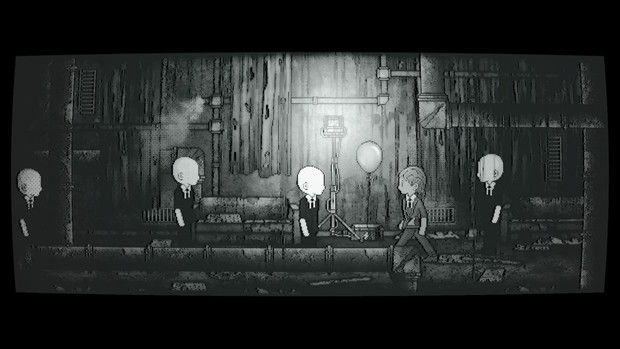Afterdream review

- 0 Comments
Haunting Jesse Makkonen side-scroller is another eerie but thought-provoking psychological horror adventure
Life and death make reluctant but unavoidable bedfellows. The older we get, the more often we have to say goodbye to the people we love. But what if you never got the chance to have that final talk with a special someone, that last embrace? And what if you continued to blame yourself for that? Perhaps you might suffer terrible nightmares, like Jennifer does in Jesse Makkonen’s Afterdream. In this 2D psychological horror story, you are transported to the protagonist’s lucid dream world, which plays as one big, freaky escape room. Armed only with a peculiar black-and-white Polaroid camera, players will need to help Jennifer face her fears to finally find that hoped-for resolution. What follows is a short but marvelously executed game that’s good for a few chilling hours exploring the subconscious.
Jennifer, wearing a business suit but with her hair dyed strikingly blue, is talking to her therapist about a recurring dream. The therapist advises her to close her eyes, to better recollect the dream. Gameplay starts when you take control of Jen as she recounts all the peculiarities in her dream as if she’s experiencing it all for the first time. The game is divided into six chapters and an epilogue, with intermittent therapy session cutscenes.

It seems Jennifer began having this dream after the death of her father. In her dream, she is told by the NPCs inhabiting this place – spirits of other deceased – that they are in a kind of purgatory separating the living world from the afterlife. Jen’s father is already in that afterlife, but he wants to return for the chance to meet her in this purgatory. To accomplish that, Jen needs to find and activate an elusive portal object. Her path is blocked, however, by many a locked door, or a ghost in need of a favor.
Right from the start, the unique art style becomes apparent. (Unique if you’re not familiar with Makkonen’s Distraint series, at least.) You’re watching the story unfold as if on an old monochrome computer screen or surveillance system display. The edges of the screen are curved, and the pixel art graphics have a warped, greenish filter over them, until the color palette changes when you enter a different setting. Indoor scenes, like an apartment building and a huge mansion, feature more brown tones, while an outdoor countryside summer locale has brighter red and yellow hues. Lights flicker and sometimes go out completely, or become blindingly intense. Often static will distort the images, symbolizing Jennifer’s heightened stress levels or approaching terrors.

Sound effects do an excellent job conveying things unseen, adding to the creepy atmosphere. The pitter-patter of Jennifer’s footsteps changes according to the surface beneath her. Tiles, planks, puddles, carpets – each material has its own distinctly realistic sound. The dream world is further brought to life with background ambience like falling rain and the occasional telephone ringing with an almost sickening Doppler effect. Soft piano music during peaceful sections is replaced by loud, frantic guitar strumming or fast violin strokes to achieve that unnerving feeling when something scary is about to happen. It’s this striking combination of visuals and sound that takes this game to the next level, even with the lack of any voices.
While Afterdream is basically a 2D side-scroller, the game creates a three-dimensional effect in the way you move from room to room. When you walk through a door in the background, that door will be translucent in the foreground of the next room, giving the impression of venturing deeper into this nightmare. Each chapter introduces a new world with a number of rooms to explore, and it’s up to you to figure out the layout of the map and navigate efficiently through all the doors in order to solve the puzzles within. Pathways can suddenly be blocked as you progress, usually by ghost NPCs who will suddenly pop up in order to guide you along by providing the next fetch quest.
The characters look very cute in comparison with their surroundings. They are slightly larger versions of 8-bit sprites you might recognize from older roleplaying games. Jennifer is easily recognizable by her blue hair; the ghosts around her all resemble normal people. They are responsible for the game’s endearing dialogue, as they’re all souls longing to hear prayers from their loved ones back in the world of the living. Only one of them is a bit disturbing; he doesn’t have a face, and Jen finds herself often surrounded by multiple “clones” of him. He’s always very upset when you meet him, because he wants to be left alone and will always vanish like a screaming illusionist.
It wouldn’t be a true horror game without encountering some nastier creatures, though. Purgatory is also inhabited by giant, floating specters. At certain points you will have to create diversions and time your movements in order to sneak by them. You can’t die in Afterdream, but these creatures CAN catch you and will force you back a room and make you try to get by them again. Since there’s no fear of death, it’s only necessary to record your progress if you need to quit the game early. You are restricted to saving at one of the predetermined points strewn throughout the dream world, in the form of a glowing orb in the wall. There’s just one available save file that you constantly overwrite, even if you start a new game.

Afterdream doesn’t support point-and-click mouse controls, but it can be played with a controller, though I used only the keyboard. The interface is limited to six keys: four directional keys, a general action key to manipulate hotspots, and a key to equip the in-game camera, all of which you can rebind according to your preferences. The first time you encounter a new gameplay element, a top-of-the-screen prompt explains how it works and what you have to do.
The puzzles here are fairly simple. As you explore your surroundings, when you pass something interesting, like a cupboard or a drawer, a hotspot label will be indicated and you can examine it to see if it contains anything noteworthy. Useful items will be added to your inventory, which isn’t visible and can’t be accessed at will as you would in a classic adventure game. Instead, when you come across a hotspot on which it’s possible to use items, you can cycle through the items in your possession and choose the one you think will do the trick.
Here and there you will also encounter a mechanical or logic puzzle, which serve as more complicated lock systems. To solve them you’ll need to connect dots, rotate discs, slide blocks around, or enter number combinations. They make for a fun change amongst the other puzzles, and they’re never so difficult as to give you nightmares of your own.
The moment you feel you’re really stuck, that’s when Afterdream’s showpiece element comes in. Early on you’re given a nifty Polaroid camera, which can alter the dream world in some kind of augmented reality fashion. Look through the lens and search the area in first person and you’ll no doubt spot a white, pulsating object that you couldn’t see with the naked eye. Take its picture, and the object will suddenly appear for real and be at your disposal for further use. It works the other way around too: if you should find your path blocked, whip out the camera and chances are you can take a picture of the obstacle and make it disappear, opening the way to continue your quest in trying to make contact with Jen’s father.
Final Verdict
Afterdream definitely has some eerie-looking imagery and sounds, but before long it becomes obvious that this game isn’t simply a scary story but also one of grief, loss, saying goodbye, getting closure and accepting the finality of death. Even though the puzzles are on the easy side, there’s enough diversity of gameplay to keep you entertained on an interactive level. But it’s the heart-tugging story of Jennifer trying so hard to make contact with her deceased father, and her encounters with the other ghosts stuck in their own purgatory, that make this quite the emotional journey as well. It may only take three hours to finish, but it really is a dream to play through.
Hot take
Afterdream is a chilling side-scrolling adventure that combines a variety of rather easy, engaging puzzles with a creepy yet surprisingly poignant story about loss, all wrapped up in the developer’s distinctive art style.
Pros
- A creepy nightmare world to explore
- Marvelous combination of eerie visuals and sounds
- Interesting variety of puzzle types
- Tells an emotional story about loss and grief
Cons
- Little challenge makes for a rather short game
Johnny played Afterdream on PC using a review code provided by the game’s publisher.











0 Comments
Want to join the discussion? Leave a comment as guest, sign in or register in our forums.
Leave a comment